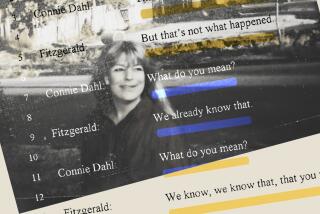The Airman and the Carpenter : THE LINDBERGH KIDNAPPING AND THE FRAMING OF RICHARD HAUPTMANN by Ludovic Kennedy (Viking: $18.95; 438 pp, illustrated)
- Share via
It was the year that Social Security was signed into law . . . that Louisiana governor Huey Long was assassinated and that “Porgy and Bess” opened on Broadway.
But unless you were very, very young, there was only one real topic of conversation in 1935--”The Trial of the Century”--the conviction of Bruno Richard Hauptmann for the kidnap/murder of 2-year-old Charles Augustus Lindbergh not quite two years earlier. The unthinkable crime against America’s greatest hero: little Charlie’s idolized father, “Lucky Lindy,” “The Lone Eagle,” Charles Lindbergh, who captured the imagination of the world in 1927 in a way that no man had done before, or since, by becoming the first person to fly solo across the Atlantic Ocean.
Even before Hauptmann was electrocuted for the crime, 15 months after his conviction, nagging doubts had already arisen about the tactics of the New Jersey state police in the handling of the case, the split loyalty of Hauptmann’s chief defense counsel, numerous instances of almost laughable, but unchallenged, perjury on the part of key prosecution witnesses, blatant suppression of evidence favorable to Hauptmann and prejudicial media coverage, the likes of which haven’t been seen before or since the carnival that erupted over the sleepy community of Flemington, N.J.
And, while Ludovic Kennedy in his admirably researched “The Airman and the Carpenter, the Lindbergh Kidnapping and the Framing of Richard Hauptmann,” can look back on a journalistic career that includes three previous books that have resulted in pardons for innocent people falsely convicted of murder, his frustration here is in the fact that the true kidnapers and murderers of little Charlie Lindbergh are as unknown today as they were on that cold night of March 1, 1932, when the scenario unfolded with its bizarre cast of characters.
The real tragedy of the Hauptmann case, of course, was that the idolatry of the American people toward Charles Lindbergh--and their shared agony of his ordeal--made any honest skepticism about the validity of the case against Hauptmann seem, somehow, a betrayal of their hero.
Author Kennedy, again and again, reminds us of how much criminal investigation, and prosecution, procedures have changed in the last 50 years. Would any judge, in 1985, accept as Hauptmann’s chief defense counsel a man the likes of flamboyant, alcoholic, William Reilly who, from the outset, was being paid by the vitriolic, Hauptmann-baiting, Hearst newspaper chain, and who--in the four months he represented Hauptmann--had exactly 38 minutes of consultation with his client? And who, time and time again, failed to press witnesses obviously perjuring themselves?
Would any police force in 1985 dare to suppress so blatantly pertinent evidence favorable to the defense? (Reilly never raised the issue that the New Jersey police found two, not one, sets of footprints at the Lindbergh home and that Hauptmann’s print matched neither of them. Nor did he challenge the only two “eyewitnesses” who put Hauptmann near the Lindbergh home prior to the kidnaping--one a notorious local liar, and the other an 87-year-old man with cataracts who, when asked to identify a vase of flowers 10 feet away declared it to be a woman’s hat).
Scholarly, methodically, author Kennedy takes the conventional case against Bruno Richard Hauptmann apart like a five-dollar watch in this step-by-step researching of a criminal prosecution that has bothered students of jurisprudence for 50 years--and with good cause.
Was Hauptmann guilty of anything? Oh, yes, quite definitely, Kennedy assures us--the misappropriation of funds left in his care. Never mind that the duplicitous, penny-ante crook, Isidore Fisch--posing as Hauptmann’s personal financial adviser--fleeced the gullible Hauptmann, and many other German-Americans like him, out of their hard-earned money and was a known dealer in hot money. And never mind that, before returning to Germany on a visit in 1934 (where he subsequently died of consumption), Fisch gave Hauptmann a shoe box to keep for him that turned out to have $14,000 in Lindbergh money in it. And, never mind that when Hauptmann found what was in the box, he appropriated that portion of it that Fisch owed him and began spending it). What happened to the balance of the $50,000 in ransom money?
We’ll never know, of course, thanks largely, again, to the police who suppressed the information that the ransom money from this supposedly one-man kidnaping continued to turn up after Hauptmann’s jailing, conviction and execution.
More to Read
Sign up for our Book Club newsletter
Get the latest news, events and more from the Los Angeles Times Book Club, and help us get L.A. reading and talking.
You may occasionally receive promotional content from the Los Angeles Times.









